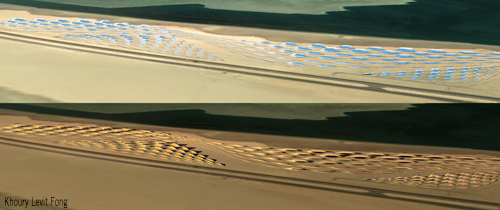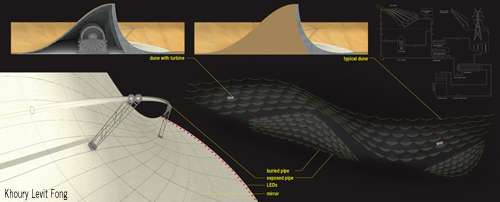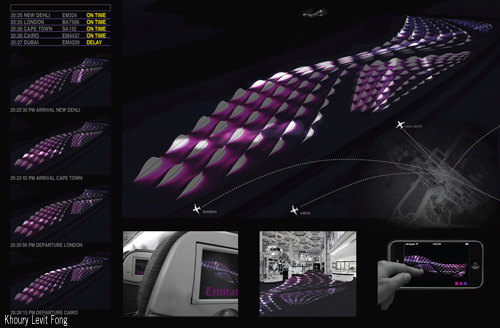Khoury Levit Fong
Robert Levit, Rodolphe el-Khoury, James Dixon, Lindsay Hochman, Khalid al Nasser, Melissa Lui
Designed for Site #2 in Abu Dhabi, between Saadiyat Island and Yas Island.

Design Submission for the 2010 Land Art Generator Initiative Design Competition
Artist’s descriptive text:
A constructed dunescape…with southern slopes of mirror-bright polished stone, lifts towards the sun. Concave eye-shaped surfaces reflect light upon pipelines, superheating their liquid contents and powering electricity generating steam turbines housed beneath their crests.
A rich pattern of mirrored eyes luminous with the sun by day and shifting patterns of LEDs by night . . . the dunescape blinks.
Solar Dunes adapts the machinery of solar powered steam generated electricity. But, here the machinic array of mirror-like surfaces is bound up in a topographical form: the dunescape.

The machine does not sit in nature as it once did (factories in the landscape), but neither does nature camouflage the machine and its detritus. Here the dunes look natural but are a work of geometry and artifice. And the polished mirrors, the piping and its supports interpose within the forms of the dunescape an element of even more obvious artifice. Taken together, the dunes and mirrors create a challenging equivocation between the natural and the artificial. The eye-like surfaces blinking in the dunescape uncannily animate the inanimate –the prosthetic quality of machinery that reproduces qualities of the body is now writ into the field of a technical landscape. The ecologically sound solar production of electrical energy is bound up in a newly conceived esthetic of landscape.
These dunes are built and stabilized: an open mat of concrete, mostly below the surface, holds their form and patterns their surface. Concrete ribs and planks form the substrate for the parabolic curvature of the mirrored surfaces. These may be of polished stone or metal as budget and performance criteria permit. The dunes rise and subside, making for a richly varied array of forms, both to look at and to occupy. Under several of the larger dunes –over ten meters in height—powerful electrical turbines will be housed. Pipes onto which the mirror surfaces reflect intense light, will carry superheated liquid to drive the electricity-generating turbines.

The solar dunescape –artificially patterned, scintillating day and night, is designed to be apprehended at different speeds, at different scales and in different media. Experienced on foot it is an immersive landscape between highway and water. The dunes, large in scale, are a park. From the northern edge, by the water, they hide their technical apparatus, and appear as somewhat excessively regular sand dune landscape. Seen from a speeding car, the patterned surfaces come into view stretched along the horizon at the speed of a blink. From an airplane, the pattern of the dunes takes on an iconic character: a logo-in-the-land identified with ecological solarpower generation and the esthetic re-conception of an industrial landscape. On a computer screen the site is patterned at a scale that is visible on Google Earth and establishes itself as logo-scape linked to the innovative synthesis of sustainable power generation and art to be established here in the UAE.
By night Solar Dunes turns into an informational ornament. The trajectory of air travel between Abu Dhabi and international destinations is mapped as trailing light patterns upon the mirrors of the dunes. LEDs embedded at the foot of each mirror brighten and dim set by the arrivals and departures from Abu Dhabi International Airport. This pattern of light-play treats information as ornament. Animated patterns are generated by the cosmopolitan globalized circumstances of life in Abu Dhabi. The pattern of lights of this energy landscape may be, in turn, used as a logo in a variety of sites: as a luminous floor pattern of the Abu Dhabi airport ticket concourse, as a screen ornament app in iPhone, as a splash screen for Emirates airlines, and elsewhere. . . This image of the new electrical landscape will be an emblem of a convergence: between sustainable energy production and environmental art.

Solar Dunes uses a conventional energy generating strategy in an unusual manner. Mirrored arrays have been used in numerous locations to melt salt, which is then pumped to steam turbines where it vaporizes the water used to drive the turbine. In our proposal we have considered two possibilities. First, a lower tech use of polished stone and a heated liquid such as glycol to produce steam. Such materials require less maintenance and are more compatible with the use of Solar Dunes as a park. The second option is that the mirrors be more conventionally machined metal mirrors—producing a maximum of heat and thus electrical power.
Related Posts
1 Comment
Add comment Cancel reply
This site uses Akismet to reduce spam. Learn how your comment data is processed.

[…] machined metal mirrors—producing a maximum of heat and thus electrical power. Source: Land Art Generator Initiative Reageer […]